On a chilly afternoon in February 2022, I reached Darjeeling bazaar’s bich galli for fieldwork. A group of women bhariyas were waiting outside the shops, some sitting in front of the closed shutters, some on video calls with their families, and some following customers to carry their loads. On being asked if they would like to talk about their lives, one woman said “Sakincha ni. Kina sakindaina?” (It can be done. Why can’t it be done?). This was a contrast in comparison to my past fieldwork attempts when women hesitantly replied, “Bolna ta aaudaina” (I cannot speak or explain). The woman who spoke up was 35-year-old N. Thami. She is a migrant bhariya from Nepal’s Bagmati Province (Kalinchok, Dolakha). Thami was married at the age of 17 and has two daughters. In 2012, the family migrated to Darjeeling as her husband’s income was insufficient. Initially, she worked as a house helper but stopped as the wages were low. Thami’s husband is also a bhariya, who worked in Darjeeling before marriage. This is a widespread pattern among many migrant bhariya couples, husbands migrate for work at an early age, whereas women migrate only after marriage. Both spouses work yet, Thami is solely responsible for the household work - her daughters and husband occasionally help. She shared, that carrying loads is tough but she works to provide better education for her daughters to prevent them from working as bhariyas.
On being asked if they would like to talk about their lives, one woman said “Sakincha ni. Kina sakindaina?” (It can be done. Why can’t it be done?). This was a contrast in comparison to my past fieldwork attempts when women hesitantly replied, “Bolna ta aaudaina” (I cannot speak or explain). The woman who spoke up was 35-year-old N. Thami.
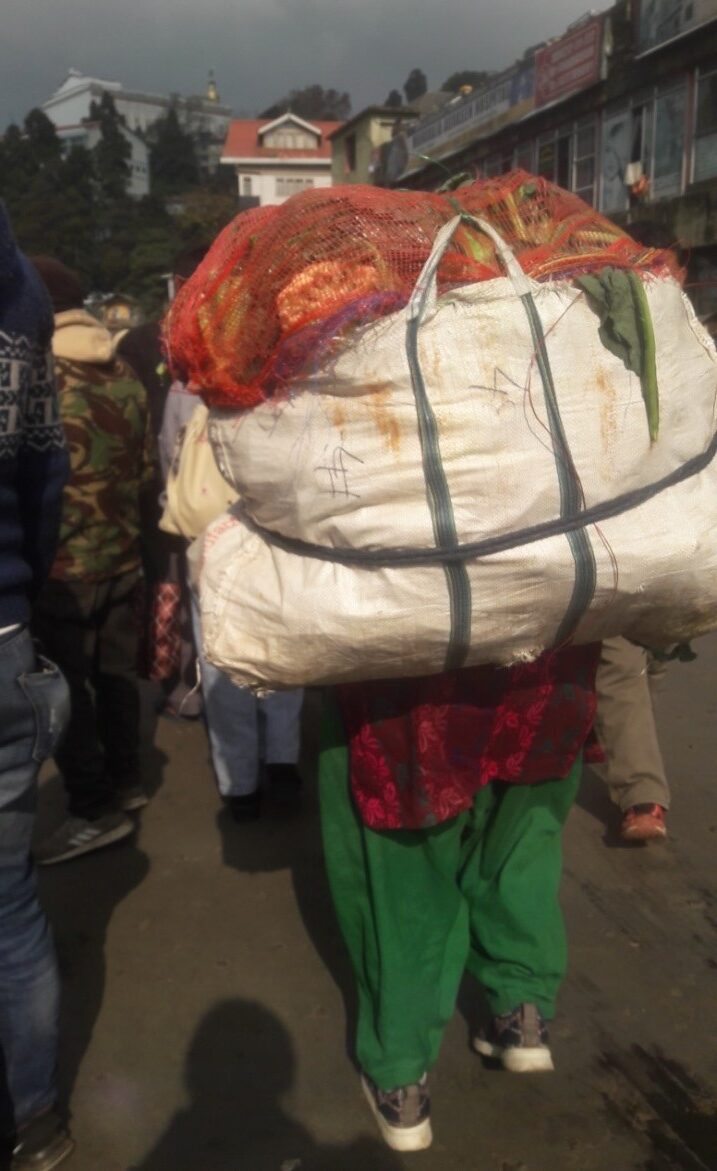
In the Eastern Himalayas, since time immemorial, people bearing loads has been a socio-cultural practice. This culture has diminished considerably, but this dependence on porters still exists where people cannot rely on technology. The Darjeeling hills, though well connected with roadways and railways are encompassed by terrain where certain forms of transport cannot reach, making porters the prime option to ferry loads. Many migrant women carry loads in the Darjeeling bazaar for their survival. During the interview, the shopkeeper beckoned Thami to carry a customer’s load for Rs 40. She quickly picked up her namlo, readily assenting to my request to tag along. Thami carried 60 kilograms of tomatoes from the sabji line to the Singamari taxi stand; she also had to load them onto the vehicle. While returning to her workstation, we encountered another returning female bhariya M.K. Thami (40 years). I followed them as they conversed in the Thami language.
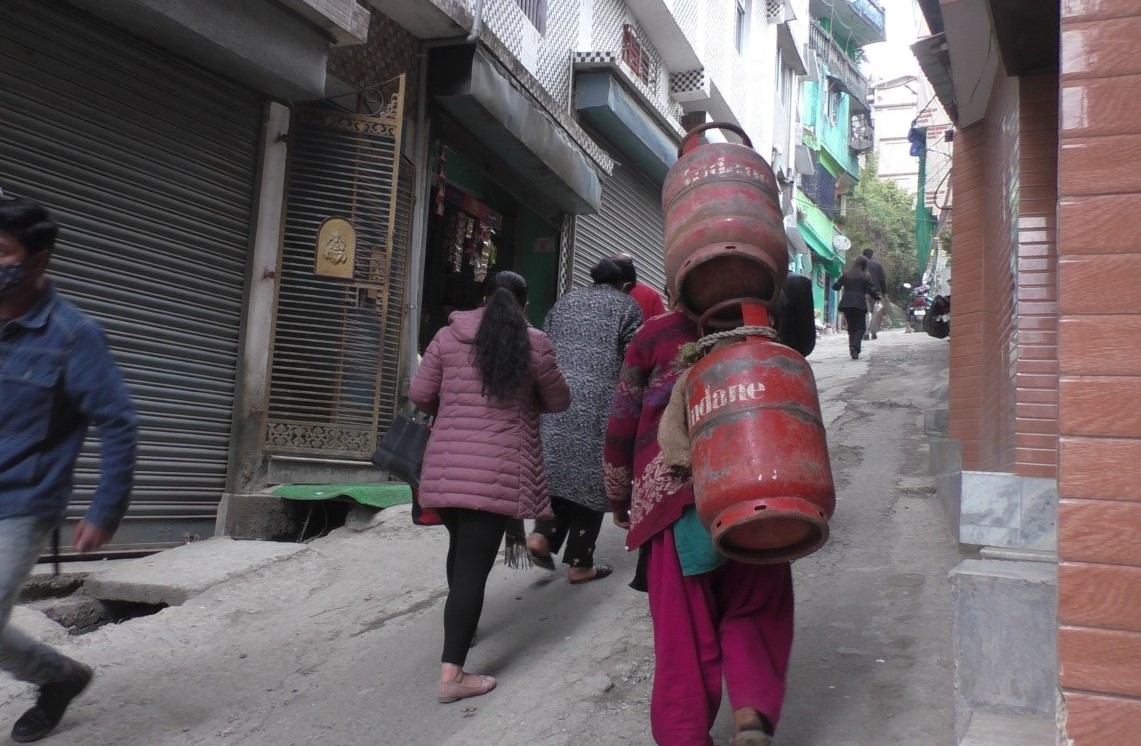
Despite many deterrents, women compelled by self-determination and poverty are entering this employment. This growing presence of women bhariyas highlights the interrelations between gender, labour, and public space in the eastern Himalayas.
Both men and women are bhariyas, but men outnumber women. Many reasons have led to this uneven composition, one of which is the ‘gendered mobility of labour’[1]. For instance, if we look at N. Thami, she migrated only after marriage while her husband migrated earlier. It was the same for all the women interviewed. Furthermore, certain social and cultural constraints hamper women from being bhariyas, such as carrying heavy loads is considered a masculine task. Despite many deterrents, women compelled by self-determination and poverty are entering this employment. This growing presence of women bhariyas highlights the interrelations between gender, labour, and public space in the eastern Himalayas. My article seeks to comprehend this connection through a small section of migrant women bhariyas who work in ‘gendered spaces’ of Darjeeling bazaar.
Who are the Bhariyas?
The Himalayan labourer, whose livelihood consists of carrying loads in the Darjeeling hills is locally known as bhariya, kulli, namlay, etc. The bhariyas mostly migrate from their hill villages in Nepal. Sharma (2018) refers to them as ‘subaltern human bodies[2]’. Every day, bhariyas wait on the roadside or in front of shops hoping to find customers. These designated spaces where they hang their namlos and wait for customers serve as their workstations.
The Himalayan labourer, whose livelihood consists of carrying loads in the Darjeeling hills is locally known as bhariya, kulli, namlay, etc... Women bhariyas, though far fewer in number than men are becoming an important part of the labour market in the Darjeeling Hills.
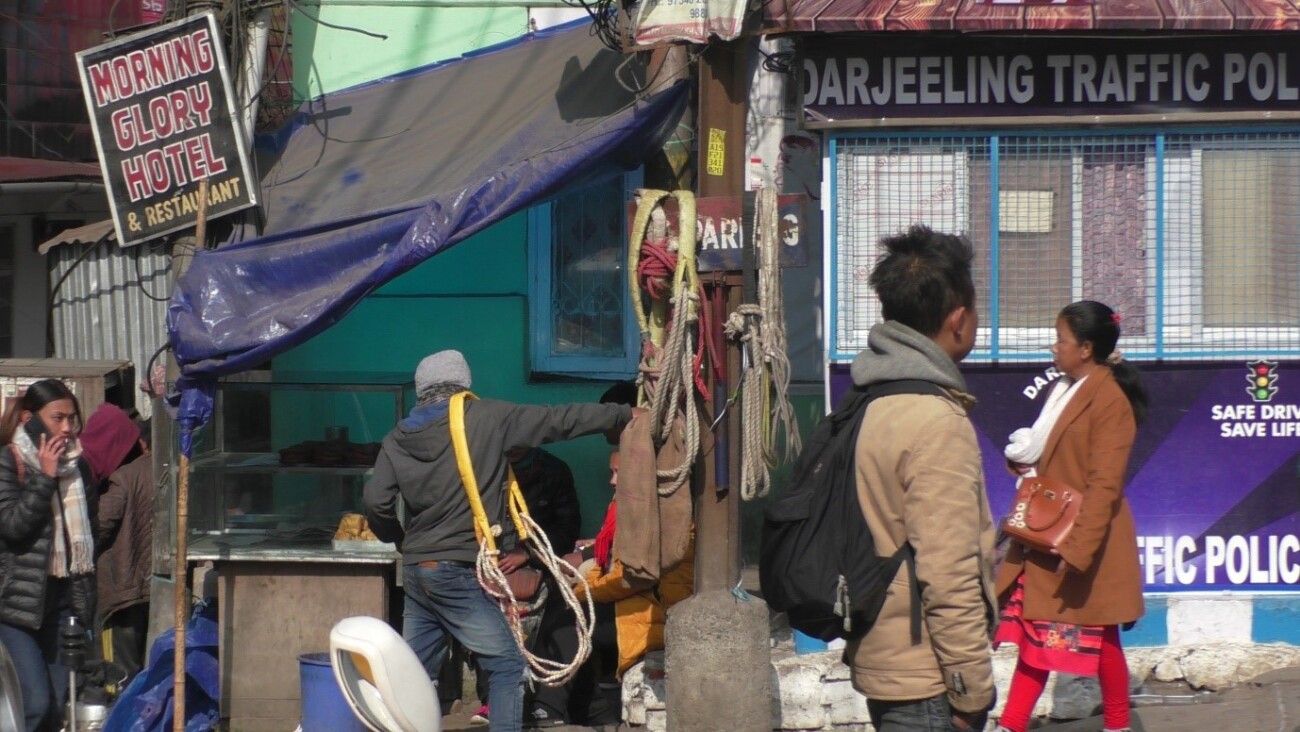
Women bhariyas, though far fewer in number than men are becoming an important part of the labour market in the Darjeeling Hills. Many are first-generation women migrants who arrived with their bhariya husbands due to poverty and indebtedness. Some women also migrated due to the decade-long (1996 -2006) Maoist insurgency in Nepal. Initially, some women worked as domestic help but the job was low-paying, so they decided to work as bhariyas. Some women began to work directly as bhariyas. Most of them considered their income supplementary to their husband’s income. However, a few bhariyas (widows /separated) were the sole breadwinners of their households. The women remain to work and look after the children, while their husbands visit home. Thami’s husband frequently visits his village, while she recently visited her parents after eight years. Her visit lasted a month, and she is unaware when she will see them again.
Gendered Work and Public Space
This section examines the relationship between porterage and ‘gendered public space’. It explores how gender plays an important role in segregating workstations. This is done by assessing the large concentration of female bhariyas in the sabji line. However, there are other workstations like Goenka Petrol Pump and Gorkha Bhavan in Chowrastha, from where both male and female bhariyas operate. Furthermore, women’s added responsibility of reproduction, restricted movement during certain hours, and their negotiation to participate in the public space are also highlighted.
According to Dave (2023) a ‘gendered space’ is a space that one or more gender groups find difficult to perceive, navigate, and occupy, often due to the other gender’s dominating presence. All or most women largely experience this.
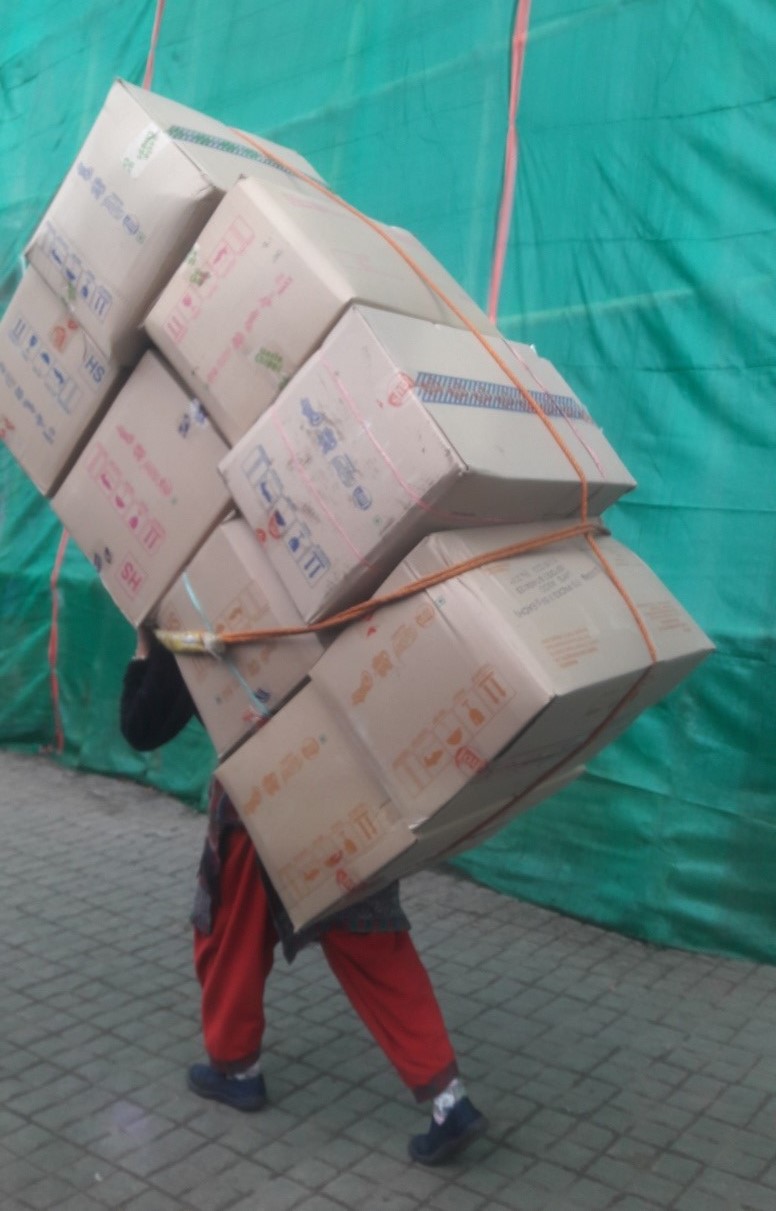
Siwach (2020) highlights that public space is commonly regarded as the site of production and belongs to men, while private space is considered a sphere of reproduction belonging to women. This understanding of ‘space’ influences the involvement of gender in particular occupations. According to Dave (2023) a ‘gendered space’ is a space that one or more gender groups find difficult to perceive, navigate, and occupy, often due to the other gender’s dominating presence. All or most women largely experience this.
A bhariya’s job appears open with no visible barriers, yet working on the streets is a challenge for most women who have never worked outside their villages in Nepal. Siwach (2020: 43) adds that “the street is a public space where social norms are manifested and displayed.” There are cultural barriers in how ‘public space’, here the streets, is used or accessed by the two genders. Some underlying barriers for women bhariyas can be seen in the time difference between the arrival and departure of the two genders to their workstations. Tamang (2022) has highlighted the aspect of ‘restrictive mobility’ among female porters. Female bhariyas return to their rented accommodations (dera) in the evening, while male bhariyas work even at night. Fenster (2005) speaks of women’s fear of harassment in public spaces (particularly at night) which cuts across their everyday life experiences. Spain (2014: 588) adds that because of these fears, women avoid certain places or modify their daily activities, forfeiting opportunities to engage in political, economic, and social pursuits.
A bhariya’s job appears open with no visible barriers, yet working on the streets is a challenge for most women who have never worked outside their villages in Nepal... Spain (2014: 588) adds that because of fears, women avoid certain places or modify their daily activities, forfeiting opportunities to engage in political, economic, and social pursuits.
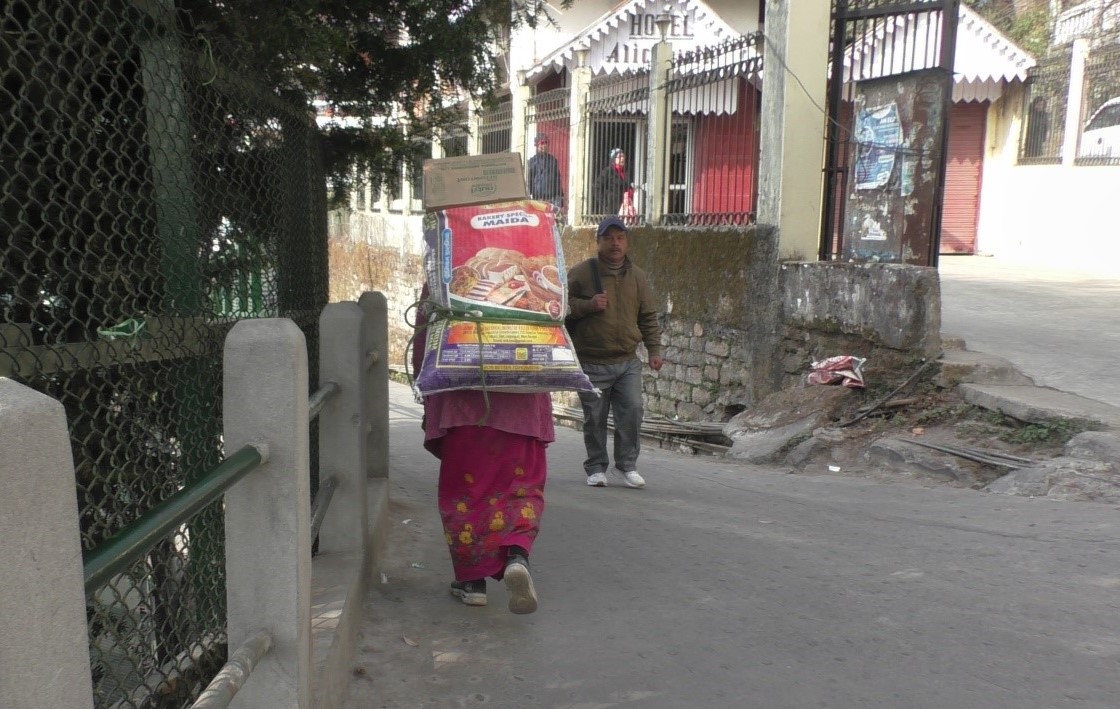
In the bazaar, there are certain spaces where the number of men bhariyas surpasses the women bhariyas, and vice-versa. No written rules indicate which group will operate in which location, yet there is a ‘silent segregation’ of spaces. In Darjeeling bazaar, the presence of women bhariyas is higher in the sabji line (vegetable market) of bich galli, while men are found at hardware and electronic stores, sawmills, etc. When asked about this disparity, the respondents replied, “Estai ta huncha” (This is how it is.). Spain (2014) has highlighted that space is produced by everyday users, and it reflects social norms and embodies gender relations.
This division is starkly visible in the transportation of construction materials, which is predominantly performed by male bhariyas since cement and concrete are unloaded during light traffic (early mornings or late nights). Meanwhile, women bhariyas rush home to prepare dinner and are unable to work early mornings because they must perform domestic duties and send their children to school. Brouder and Sweetman (2015) say ‘gender division of labour’ means most women juggle care responsibilities with income generation. Women face economic inequality in the labour market due to the continuing burden of unpaid labour that falls entirely on them (Fraser, 2014, cited in Beebeejaun, 2017, 323). Furthermore, payment for carrying construction materials is significantly higher than other loads which could explain the higher presence of men in these working spaces, leaving women to operate from spaces that pay them less.
Darjeeling Bazaar’s Sabji line
Chowk Bazaar is one of Darjeeling’s important markets. The lane where vegetables are sold is known as the Sabji line. Women bhariyas make specific shops their workstations, where they arrive every morning and wait for customers. A particular shop might be a workstation for a group of bhariyas, the number varying for each group. S. Chettri (41 years) who has been working for more than 12 years, stated that her group consists of 8-10 women. R. Thami (46 years) who has been working for over 15 years, has three women in her group. The women also have different ways of operating. Some bhariyas are employed by shop owners to carry their customers’ loads, while some bhariyas don’t work for specific shops and wait for customers. The role of social networks plays a crucial role in helping new migrants find their workstations.
The sabji gali is a ‘gendered space’ dominated by women. Women bhariyas prefer to work here because the chances of getting regular customers are better. The other reason might also be the presence of mostly women customers.
There is no formal process to enter this labour market, one can simply arrive with a namlo and start working as a bhariya. When asked how she started working, N. Thami said “Afai aayera, afai bokeko” (I came by myself and started carrying loads). Initially, she faced difficulties being unfamiliar with the routes, “I used to get confused, and occasionally return to the shop being unable to figure out where I needed to drop the load.” Later, a shop owner asked her to wait at his shop and carry his customers’ loads.
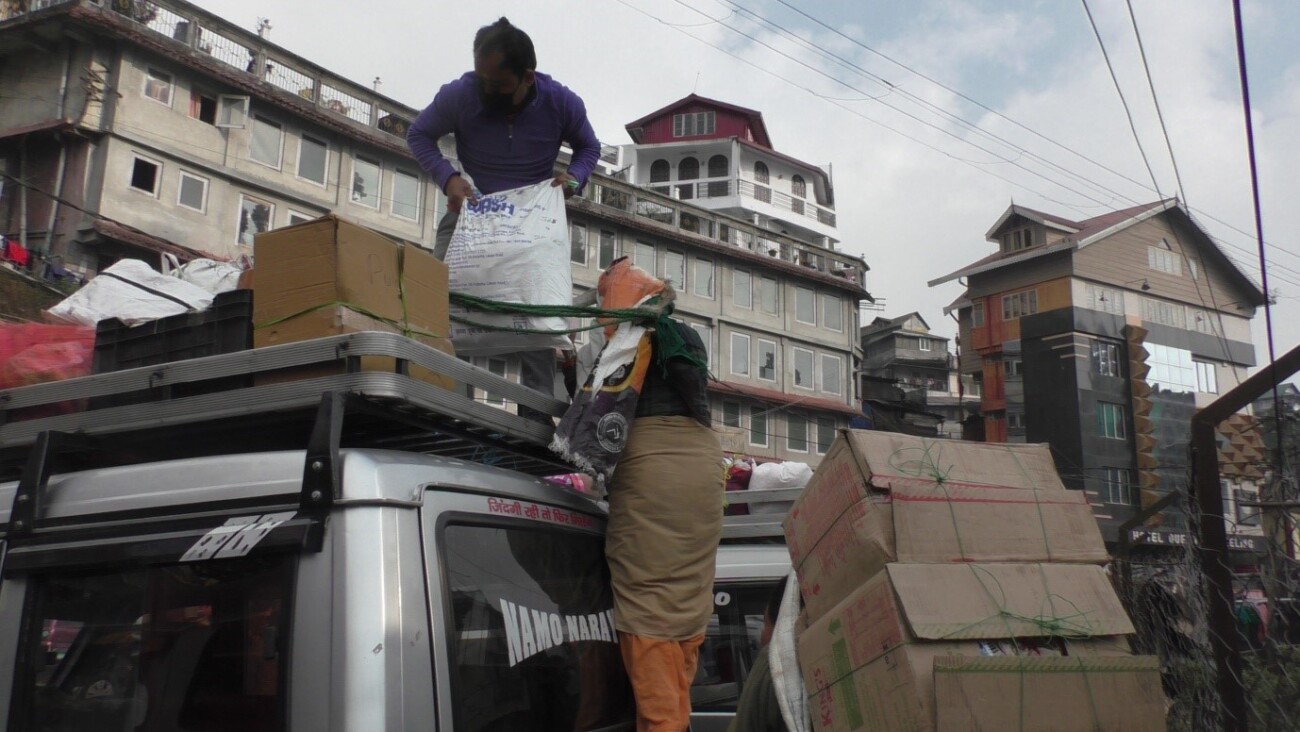
Their daily routines depend on the work. The women reach the sabji line by 9 a.m. and work till 5-6 p.m. The area is crowded on Mondays, Wednesdays, and Fridays as fresh vegetables arrive on these days. On Thursdays, they stay home as the market is closed. If there is any work, the shopkeepers call them. But the shopkeepers don’t pay them, they receive payments solely from their customers. Sometimes, the shopkeepers give them leftover vegetables. Their daily earnings also vary between Rs. 50 to Rs. 300 (on average); some days they don’t earn anything. They shared, “Koi bela ta chiya khanay paisa pani hudaina” (Sometimes there is no money even for tea).
Their daily routines depend on the work. The women reach the sabji line by 9 a.m. and work till 5-6 p.m. Their daily earnings also vary between Rs. 50 to Rs. 300 (on average); some days they don’t earn anything. They shared, “Koi bela ta chiya khanay paisa pani hudaina” (Sometimes there is no money even for tea).
The sabji gali is a ‘gendered space’ dominated by women. Women bhariyas prefer to work here because the chances of getting regular customers are better. The other reason might be the composition of customers. Spain (2014: 582) says that spaces (marketplaces) become gendered through their clientele. Dave (2023) has analyzed Mumbai’s ‘gendering of the street’ through the relationship between markets and female customers, she describes how female customers running errands completely occupy that space. This ‘gendering of the street’ could explain the higher presence of female customers and bhariyas in the sabji line.
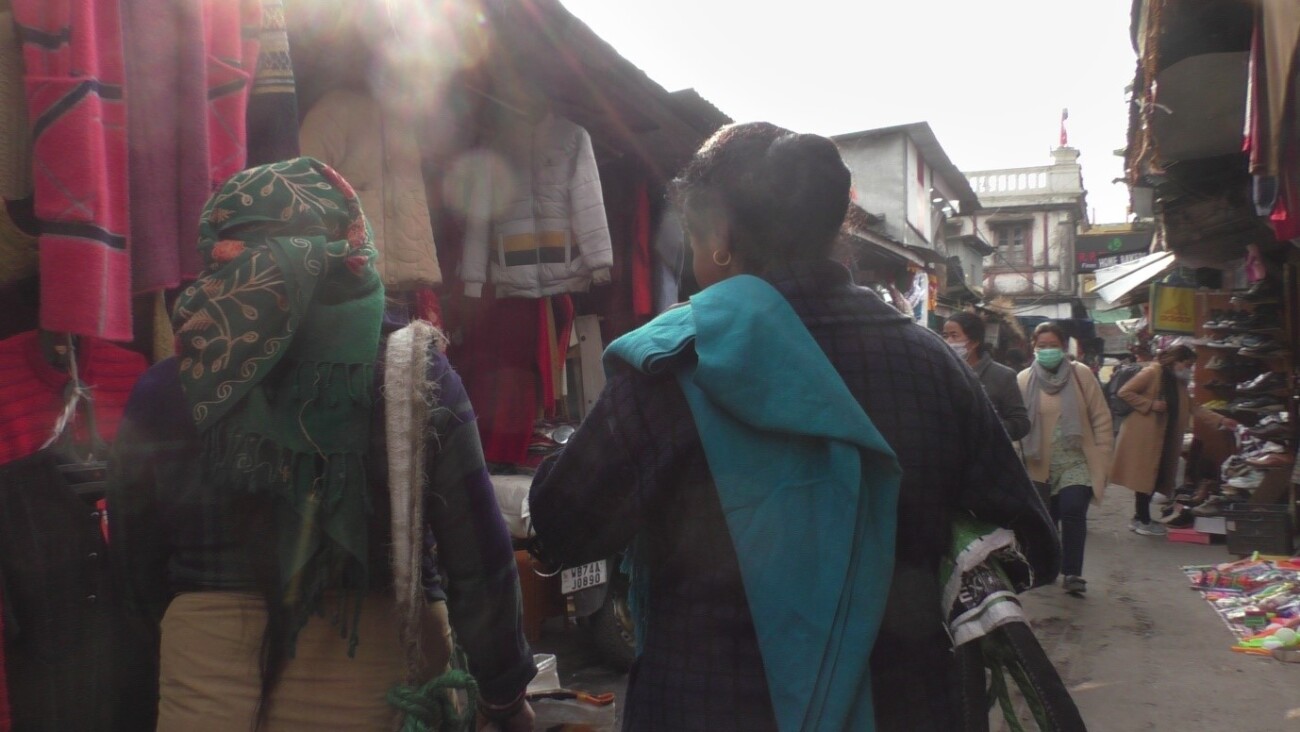
The streets become a space of socialisation for the bhariyas where they sit, converse, and exchange stories of their lives. Even if their children prevent them from working, some women visit the bazaar being accustomed to spending time with other bhariyas
Nunez (1993: 67) presents a positive relationship between women labourers and public spaces, “the street, as a physical and symbolic space, becomes the scene where women defy values that reinforce their subordination and act as a space for socialization.” The streets become a space of socialisation for the bhariyas where they sit, converse, and exchange stories of their lives. Even if their children prevent them from working, some women visit the bazaar being accustomed to spending time with other bhariyas.
Conclusion
Bhariyas are an essential part of Darjeeling Hills’ bazaars. Though monetary returns are meagre, carrying loads provide a livelihood for hundreds of impoverished and marginalised households. The occupation of a bhariya is a male-dominated field, with unequal participation of male and female labourers. The question arises, has the association of economic transactions made this occupation gendered? A small section of migrant women is challenging the stereotyped gender roles by entering the public space as bhariyas. Throughout the eastern Himalayas, similar changes to a certain extent can be witnessed in other male-dominated occupations. For instance, Thompson (2013) discusses how female trekking guides in Nepal are claiming space in the traditionally masculine public realm.
When women navigate and occupy specific spaces outside their private domain, they destabilize the socio-cultural values and beliefs that reinforce the stereotypes around gender and labour.
Women negotiate and struggle to be a part of the public space. Public places don’t specifically prohibit women bhariyas from carrying loads, but there are noticeable gender norms that create invisible boundaries dividing the public space. In Darjeeling Bazaar, ‘gendered spaces’ have been created by the ‘silent segregation’ of workstations. Women bhariyas are concentrated in spaces like the sabji line that give less monetary return than higher-paying work like carrying construction materials, electronic goods, lumber, etc. This segregation also demonstrates the layered aspect of gender inequalities where women are provided a space to work, yet certain spaces remain outside their purview. When women navigate and occupy specific spaces outside their private domain, they destabilize the socio-cultural values and beliefs that reinforce the stereotypes around gender and labour.
Lastly, though this small section of female bhariyas does not wholly represent the entire bhariya population in the Darjeeling Hills, this article focuses on porterage work to understand the larger context of gender, labour, and public spaces in the eastern Himalayas.
[1] The gendered movement of people from one place to another for employment, within a country or across borders
[2] Marginalised people
References:
- Sharma, J. (2018). ‘Himalayan Darjeeling and Mountain Histories of Labour and Mobility’, In Townsend Middleton & Sara Shneiderman (eds), Darjeeling Reconsidered, 74-96, New Delhi: Oxford University Press.
- Siwach, P. (2020). Mapping Gendered Spaces and Women's Mobility: A Case Study of Mitathal Village, Haryana. The Oriental Anthropologist. 20(1): 33-48.
- Dave, S. (October 6, 2023). How women perceive, navigate and occupy public spaces and streets. Questions of Cities. https://questionofcities.org/how-women-perceive-navigate-and-occupy-public-spaces-and-streets/ (Accessed on 16.02.2024).
- Tamang, Y. (2022). Migrant Women Labourers at the Borders: The Vulnerabilities of Seasonal Trans-national Women Labourers in Darjeeling. In Mona Chettri with Ktien Hima & Nikita Rai (ed), Gender, Sexual/Other Identities in the Eastern Himalaya, 29-44, Sikkim: Rachna Books and Publications.
- Fenster, T. (2005). The Right to the Gendered City: Different Formation of Belonging in Everyday Life. Journal of Gender Studies. 14(3): 217-231.
- Spain, D. (2014). Gender and Urban Spaces. Annual Review of Sociology. 40: 581-598.
- Brouder, A., & Sweetman, C. (2015). Introduction: Working on gender issues in urban areas. Gender and Development. 23(1): 1-12.
- Fraser, N. (2014). Fortunes of Feminisim: From women's liberation to identity politics to anti-capitalism. London, England: Verso.
- Beebeejaun, Y. (2017). Gender, urban space, and the right to everyday life. Journal of Urban Affairs. 39(3): 323-334.
- Nunez, L. (Oct 30, 1993). Women on the Streets: Vending and Public Space in Chile. Economic and Political Weekly. 28(44): 67-82.
Ambika is a PhD research scholar at the Centre for Himalayan Studies (CHS), University of North Bengal. She completed her MA in Sociology from the University of North Bengal and her M.Phil. from CHS, NBU. Her research interests include transnational labour mobility, gender, and the informal sector in the eastern Himalayas.In 2016, she was a fieldwork assistant for three months in Jalpaiguri to a junior researcher from the University of Amsterdam. She also worked as a field assistant for three weeks in Sikkim on December 2019 for the University of Vienna’s anthropology research project. In February 2020, her photographs were exhibited in Zubaan’s ‘Through Her Lens’ photography exhibition under the theme ‘Memory and Migration’ in Namchi, Sikkim.
This article is a small part of the ethnographic research from her doctoral fieldwork conducted in Darjeeling Hills from December 2021 to January 2023. Open-ended, semi-structured interviews, and informal group discussions with the respondents were conducted at various workstations, tea stalls, etc, as well as at their residences.
I am highly indebted to all the respondents who shared their time and stories with me. I am grateful to the Sikkim Project team and Bibhusha for providing me with this platform to share my work. I would also like to express my gratitude to Dr. Mona Chettri for her invaluable feedback on the article’s initial draft.
23 comments on “PORTERAGE AND PUBLIC SPACE: THE WOMEN BHARIYAS OF DARJEELING BAZAAR”
Leave a Reply
Latest Posts
Latest Comments
No 'Comments_Widget_Plus_Widget' widget registered in this installation.


Spot on with this write-up, I really feel this web site
needs much more attention. I'll probably be returning to
read through more, thanks for the information!
Outstanding study! The empathy with the subjects is palpable. It is a tough life. The health and medical issues of these women must be serious, given the nature of their work. And neglect of their children's welfare and education. The state certainly needs to do more for working women to provide good-quality creches, health facilities, and health insurance.
Indeed! However, the nature of their identity stands as a barrier in this respect.
Certain CSOs help them in some areas, mainly child care, but a lot needs to be done.
The article was very well written, such a vivid representation of the most important labor segment of the urban areas in Darjeeling town did help me question the popular understandings of the labor-capital relation in Darjeeling. More power to you and your writings Nana.
Thank you Ujjal.
As a man, it’s hard to digest that a woman can carry heavy loads to earn their livelihood and perform household duties simultaneously. This time reality hit me hard. I am in the process of digesting the difficulties faced by the women bhariyas. They are the fighters in our society.
Thank you for pointing out this crucial aspect related to the invisible work of women, especially in the private sphere, which goes unnoticed many times.
Your article was incredibly informative and skillfully written. I loved reading it di. Best wishes.
Thank you, Anamika, for your kind words. Glad you liked it.
You are born and meant to do this! More power to you Ambay!🤍🤌
Thank you Nupay🥹💕 Means a lot💫
Very informative and thoughtful topic, your writing really got me thinking about the subject matter..Best wishes 💕 keep enlighten us with these types articles
Thank you for taking the time to read this article Priya💕
I really enjoyed reading your article. Very well articulated di. I know how much hardwork you have put in to bring this up. My best wishes to you.
Thank you so much Tshumila. Thanks for always listening, questioning and providing feedbacks😊💫
good job ambu..hope the fluent of writing goes on in future too...my best wishes for u....
Thank you so much!
I appreciate the effort you put in your article you did a great job keep it up. ... ❤️👍🏻
Thank you for reading
💫💌
This article has impressively portrayed about the gender space and stereotypes around gender which is related with the female bhariyas and is a topic rarely spoken about. Good article keep going💗
Thank you so much 💌
Thank you Numa. Glad you liked it.
Truly an exceptional research topic. Loved your article and the lens you have used to dissect the story of women ‘bhariyas’. Best wishes💜